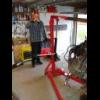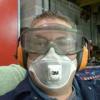
Welding Gas
#1

Posted 10 August 2016 - 02:37 PM
My other minis been on road for 4 years and passed MOTs fine,I ask each time to check welds and he keeps saying "there not the prettiest but their not cracking coming apart so don't worry" so stick to co2 or choose one of the others???
Thanks Ian
#2

Posted 10 August 2016 - 03:07 PM
You do get a better finish with Argon CO2 mix, but the actual weld itself is down to you. Power and wire speed plus cleanliness of the area being welded play very major parts in producing a clean strong weld.
#3

Posted 10 August 2016 - 04:27 PM
Ac
Edited by ACDodd, 10 August 2016 - 04:28 PM.
#4

Posted 10 August 2016 - 06:51 PM
Look for 200 bar cylinders some of the suppliers only do 137 bar in the smaller 9/10litre bottles. The best option for restoration project with mig gas is to go for a 20 litre cylinder at 200 bar fill. Argon co2 mix is much better than co2. Go for 5% mix for car panel work. I use sgs gasses via Motorparts. Quality cylinders.
Ac
What difference would the pressure make?
Thanks both for replying.
#5

Posted 10 August 2016 - 06:54 PM
What difference would the pressure make?Look for 200 bar cylinders some of the suppliers only do 137 bar in the smaller 9/10litre bottles. The best option for restoration project with mig gas is to go for a 20 litre cylinder at 200 bar fill. Argon co2 mix is much better than co2. Go for 5% mix for car panel work. I use sgs gasses via Motorparts. Quality cylinders.
Ac
Thanks both for replying.
Much better value for money so last longer and give you a better "shroud" for longer.
#6

Posted 10 August 2016 - 07:02 PM
#7

Posted 10 August 2016 - 08:00 PM
10litre at 137 bar is only 1370litres. Its important to know the amount of gas inside. Value for money.
I have just replaced my BOC oxygen cylinder, with a rent free option. For the amount I use I needed the 30litre cylinder for it to become cost effective.
Ac
Edited by ACDodd, 10 August 2016 - 08:01 PM.
#8

Posted 11 August 2016 - 08:31 AM
Higher the pressure the more gas. 20litre cylinder at 200bar is 4000litre of gas.
10litre at 137 bar is only 1370litres. Its important to know the amount of gas inside. Value for money.
I have just replaced my BOC oxygen cylinder, with a rent free option. For the amount I use I needed the 30litre cylinder for it to become cost effective.
Ac
Well that does work out cheaper!!
One last thing if you don't mind ,now I have people's attention, what sort of pressure should be used when welding?
Thanks again Ian
#9

Posted 11 August 2016 - 09:03 AM
Ac
#10

Posted 11 August 2016 - 10:45 AM
A flow rate regulator as used with argon etc is useless as a true pressure regulator as required for oxy-acetylene etc. But a pressure regulator will work, sort of, for argon, although you would be running very near the bottom of its range.
#11

Posted 11 August 2016 - 10:48 AM
#12

Posted 11 August 2016 - 02:15 PM
If I happen to be welding outside with a shelter around me I will up the gas pressure enough to ensure any sudden gusts of wind that happen to spring up do not affect the weld.
Not scientific at all, just using your hearing. Oh and been doing it this way for 25+ years now. You only need to look at the state of your welds to see if there is enough gas shrouding the weld.
#13

Posted 11 August 2016 - 05:16 PM
You need much more flow, and of course pure argon, for ali, and often a special setup with argon on the back of the weld too for stainless and other exotic metals but for car bodywork life is fortunately much simpler.
I must admit that I have never used MIG outdoors in anything except perfectly calm weather.
#14

Posted 12 August 2016 - 03:43 PM
Ian
1 user(s) are reading this topic
0 members, 1 guests, 0 anonymous users















